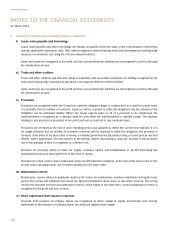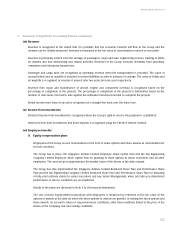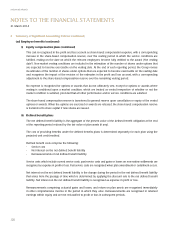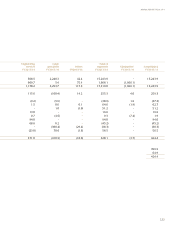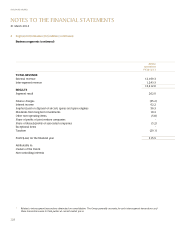Singapore Airlines 2014 Annual Report Download - page 130
Download and view the complete annual report
Please find page 130 of the 2014 Singapore Airlines annual report below. You can navigate through the pages in the report by either clicking on the pages listed below, or by using the keyword search tool below to find specific information within the annual report.
128
NOTES TO THE FINANCIAL STATEMENTS
31 March 2014
SINGAPORE AIRLINES
2 Summary of Significant Accounting Policies (continued)
(ai) Derivative financial instruments and hedging
The Group uses derivative financial instruments such as forward currency contracts, foreign currency option contracts,
cross currency swap contracts, interest rate swap contracts, interest rate cap contracts, jet fuel option contracts, jet fuel
swap contracts and jet fuel collar contracts to hedge its risks associated with foreign currency, interest rate and jet fuel
price fluctuations. Such derivative financial instruments are initially recognised at fair value on the date on which a
derivative contract is entered into, and are subsequently re-measured at fair value.
Any gains or losses arising from changes in fair value on derivatives that do not qualify for hedge accounting are taken
directly to the profit and loss account.
The Group also sets aside USD deposits to match forecast capital expenditure requirements. To create a USD-
denominated asset in the statement of financial position to match against the expected USD liability for capital
expenditure, the Group accumulates USD over a period of 10 months in advance of forecast aircraft payments.
The exchange gains and losses of the USD held would be recognised in the carrying value of the aircraft.
At the inception of a hedge relationship, the Group formally designates and documents the hedge relationship to
which the Group wishes to apply hedge accounting and the risk management objective and strategy for undertaking
the hedge. The documentation includes identification of the hedged item or transaction, the hedging instrument,
the nature of the risk being hedged and how the Group will assess the hedging instrument’s effectiveness in
offsetting the exposure to changes in the hedged item’s (or transaction’s) cash flows attributable to the hedged risk.
Such hedges are expected to be highly effective in achieving offsetting changes in cash flows, and are assessed on
an ongoing basis to determine that they have been highly effective throughout the financial reporting periods for
which they are designated.
Derivatives are classified as fair value through profit or loss unless they qualify for hedge accounting. Hedges which
meet the criteria for hedge accounting are accounted for as cash flow hedges.
For cash flow hedges, the effective portion of the gain or loss on the hedging instrument is recognised directly in the
fair value reserve [Note 16(d)], while the ineffective portion is recognised in the profit and loss account.
Amounts taken to the fair value reserve are transferred to the profit and loss account when the hedged transaction
affects profit or loss, such as when a forecast sale or purchase occurs. If the hedged item is a non-financial asset or
liability, the amounts taken to the fair value reserve are transferred to the initial carrying amount of the non-financial
asset or liability.
(aj) Segmentreporting
(i) Business segment
For management purposes, the Group is organised into operating segments based on the nature of the services
provided which are independently managed by the respective segment managers responsible for the performance
of the respective segments under their charge. The segment managers report directly to the Management of the
Company who regularly review the segment results in order to allocate resources to the segments and to assess
the segment performance. Additional disclosures on each of these segments are shown in Note 4, including
the factors used to identify the reportable segments and the measurement basis of segment information. The
significant business segments of the Group are airline operations, engineering services and cargo operations.






